Increasing the ‘Maine’ Sources of U.S. Aquaculture
INSIDE ACADEMIA
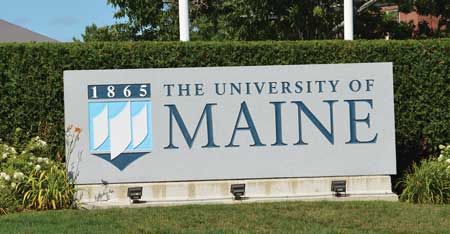 Global aquaculture production has increased annually by 8.3% since 1970, which makes it the fastest-growing form of food production in the world. Moreover, about half of the seafood in the United States is produced through aquaculture. The term “aquaculture” might conjure images of fish and shellfish farms, but the field is not limited to farming fish. Marine aquaculture supplies seafood and sea vegetables; it also supports local fisheries, restores marine habitats, and sustains and increases economic activity in coastal communities. Nowhere is that more apparent than along the Gulf of Maine, where researchers at the University of Maine are working to grow the aquaculture industry for aquatic species native to the Maine coast and to enhance Maine seafood industries being impaired by an invasive species and depleted fish stocks. Through projects and programs implemented in collaboration with the state of Maine and the National Science Foundation, the university’s researchers are helping to position seaweed as a fresh sea vegetable, investigating processing methods to increase the shelf life of fresh sea vegetables, conceiving value-added products made with an invasive species, and promoting aquaculture as a way to address food security issues.
Global aquaculture production has increased annually by 8.3% since 1970, which makes it the fastest-growing form of food production in the world. Moreover, about half of the seafood in the United States is produced through aquaculture. The term “aquaculture” might conjure images of fish and shellfish farms, but the field is not limited to farming fish. Marine aquaculture supplies seafood and sea vegetables; it also supports local fisheries, restores marine habitats, and sustains and increases economic activity in coastal communities. Nowhere is that more apparent than along the Gulf of Maine, where researchers at the University of Maine are working to grow the aquaculture industry for aquatic species native to the Maine coast and to enhance Maine seafood industries being impaired by an invasive species and depleted fish stocks. Through projects and programs implemented in collaboration with the state of Maine and the National Science Foundation, the university’s researchers are helping to position seaweed as a fresh sea vegetable, investigating processing methods to increase the shelf life of fresh sea vegetables, conceiving value-added products made with an invasive species, and promoting aquaculture as a way to address food security issues.
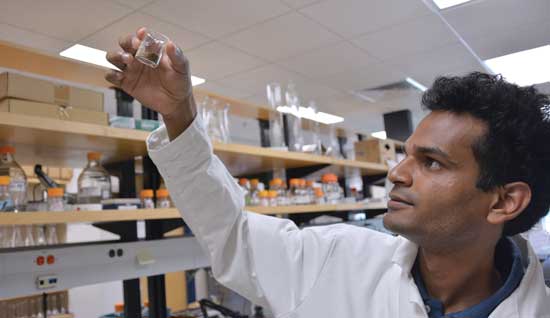 Seaweed: The Marine-Based Vegetable
Seaweed: The Marine-Based Vegetable
Seaweeds are nutrient-dense marine macroalgae possessing varying amounts of omega-3 fatty acids and other lipids, carbohydrates, protein, vitamins, minerals, and other compounds. Companies in Maine have been harvesting and selling wild seaweed as a dried product for more than 40 years. In fact, the high nutrient content and unique taste of seaweed have made it an industry worth more than $1 billion in the United States and more than $6 billion a year globally. Consequently, seaweed is an important product native to the Maine coast, but two factors are affecting the future of Maine’s edible seaweed industry: 1) the volume of wild harvest seaweed is inadequate to meet a rising demand for edible seaweeds and 2) global warming is causing ecological changes to Maine’s coastal waters, which will affect the natural growing season of its edible wild seaweeds. There is a unique opportunity to culture these sea vegetables to diversify Maine’s seafood industry, and key to realizing this potential is identifying the best seaweed strains for aquaculture development, developing new seaweed products to expand the market for aquaculture sea vegetables, and identifying the best techniques to process sea vegetables for product development.
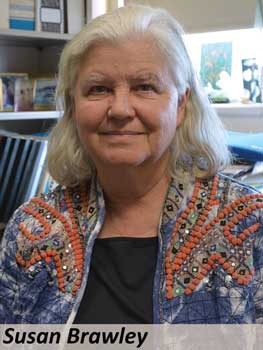 Maine’s clean, cold waters and abundant coastline are a natural habitat for certain brown algae and red algae, so naturally, these are the types of seaweed that are ideal for aquaculture development. In particular, three types of brown macroalgae have emerged as commercially important in Maine for new and existing markets: sugar kelp (Saccharina latissimi), winged kelp (Alaria esculenta), and horsetail kelp (Laminaria digitate). “Although sea vegetables are collected sustainably on the Maine coast and have been sold for decades by several very ecologically, sustainably minded [companies], as the interest in sea vegetables grows, we really need to move towards at least a mixture of aquaculture and wild harvest. Also, we can almost certainly extend the growing season by growing things in aquaculture,” says Susan Brawley, a professor of marine science at the University of Maine. Brawley is one of several researchers who are trying to understand how aquaculture on the Maine coast can be developed in the face of environmental changes. She and her research team are identifying traits and isolating strains of seaweeds that will continue to grow as Maine’s coastal environment adjusts over time. “As part of that work, my lab … is trying to develop temperature-tolerant strains of Alaria. Alaria is an Atlantic and Pacific alga and is the closest thing we have to the Japanese alga called wakame, which is commercially valuable,” Brawley says. “Because it is a subarctic alga, however, the southern range of Alaria doesn’t extend too much farther down the American coast than Maine. It’s growing very well here now, [but] we know that the Gulf of Maine is warming. So we want to isolate strains that have temperature tolerance and therefore will be useful for a long time.” Besides determining tolerance properties, Brawley and her team are investigating which strains of the brown alga grow rapidly, so that the time between harvests can be shortened, and determining ideal light and nutrient conditions.
Maine’s clean, cold waters and abundant coastline are a natural habitat for certain brown algae and red algae, so naturally, these are the types of seaweed that are ideal for aquaculture development. In particular, three types of brown macroalgae have emerged as commercially important in Maine for new and existing markets: sugar kelp (Saccharina latissimi), winged kelp (Alaria esculenta), and horsetail kelp (Laminaria digitate). “Although sea vegetables are collected sustainably on the Maine coast and have been sold for decades by several very ecologically, sustainably minded [companies], as the interest in sea vegetables grows, we really need to move towards at least a mixture of aquaculture and wild harvest. Also, we can almost certainly extend the growing season by growing things in aquaculture,” says Susan Brawley, a professor of marine science at the University of Maine. Brawley is one of several researchers who are trying to understand how aquaculture on the Maine coast can be developed in the face of environmental changes. She and her research team are identifying traits and isolating strains of seaweeds that will continue to grow as Maine’s coastal environment adjusts over time. “As part of that work, my lab … is trying to develop temperature-tolerant strains of Alaria. Alaria is an Atlantic and Pacific alga and is the closest thing we have to the Japanese alga called wakame, which is commercially valuable,” Brawley says. “Because it is a subarctic alga, however, the southern range of Alaria doesn’t extend too much farther down the American coast than Maine. It’s growing very well here now, [but] we know that the Gulf of Maine is warming. So we want to isolate strains that have temperature tolerance and therefore will be useful for a long time.” Besides determining tolerance properties, Brawley and her team are investigating which strains of the brown alga grow rapidly, so that the time between harvests can be shortened, and determining ideal light and nutrient conditions.
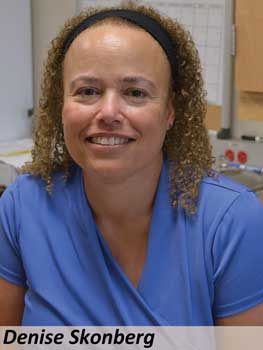 While Brawley and her team work on ideal growing conditions for sea vegetables, other researchers work on finding ways to maximize the market potential for seaweed. “Our focus is to try and develop technologies and/or products—or at least do the science that leads to technologies and products—that can either bring more economic benefits to the state through its seafood and aquaculture industries,” says Denise Skonberg, an associate professor of food science at the University of Maine. Until recently, the bulk of Maine’s seaweed crops were sold as dry products. But Skonberg and her research team are working on an emerging market for macroalgae that is poised for significant growth: “A lot of our focus has been fresh seaweed because that’s what’s really new. If you look at the research that’s been done before, a lot of it has been done in the East and on dried product. Maine can’t compete with dried product because there’s a huge market already. Where we can shine really is in the development of fresh sea vegetables,” Skonberg states. “We’re really thinking of it as a part of the plate. If you’ve got protein at the center of the plate and a vegetable on the side, then [sea vegetables] would be the vegetable on the side.” Sugar kelp, winged kelp, and dulse (a red alga) figure prominently in Skonberg’s laboratory as she and her team work to develop the concept of fresh sea vegetables, and companies, such as Ocean Approved in Portland, Maine, are already benefitting from Skonberg’s research: “Our sea vegetable work is directly applied. … We’re providing the data immediately to the growers,” Skonberg says. Ocean Approved, which grows seaweed and harvests wild seaweed, develops and markets fresh sea vegetable products. The university is also investigating additional products to develop using sea vegetables. “We are getting ready to launch a large Internet consumer survey to learn just that. Convenience will be important, and addition of seaweed to more familiar foods such as salads, soups, and side dishes will likely be most successful,” reveals Mary Ellen Camire, a professor of food science and human nutrition at the University of Maine.
While Brawley and her team work on ideal growing conditions for sea vegetables, other researchers work on finding ways to maximize the market potential for seaweed. “Our focus is to try and develop technologies and/or products—or at least do the science that leads to technologies and products—that can either bring more economic benefits to the state through its seafood and aquaculture industries,” says Denise Skonberg, an associate professor of food science at the University of Maine. Until recently, the bulk of Maine’s seaweed crops were sold as dry products. But Skonberg and her research team are working on an emerging market for macroalgae that is poised for significant growth: “A lot of our focus has been fresh seaweed because that’s what’s really new. If you look at the research that’s been done before, a lot of it has been done in the East and on dried product. Maine can’t compete with dried product because there’s a huge market already. Where we can shine really is in the development of fresh sea vegetables,” Skonberg states. “We’re really thinking of it as a part of the plate. If you’ve got protein at the center of the plate and a vegetable on the side, then [sea vegetables] would be the vegetable on the side.” Sugar kelp, winged kelp, and dulse (a red alga) figure prominently in Skonberg’s laboratory as she and her team work to develop the concept of fresh sea vegetables, and companies, such as Ocean Approved in Portland, Maine, are already benefitting from Skonberg’s research: “Our sea vegetable work is directly applied. … We’re providing the data immediately to the growers,” Skonberg says. Ocean Approved, which grows seaweed and harvests wild seaweed, develops and markets fresh sea vegetable products. The university is also investigating additional products to develop using sea vegetables. “We are getting ready to launch a large Internet consumer survey to learn just that. Convenience will be important, and addition of seaweed to more familiar foods such as salads, soups, and side dishes will likely be most successful,” reveals Mary Ellen Camire, a professor of food science and human nutrition at the University of Maine.
Learn how researchers at the University of Maine are working to create an economically viable aquaculture industry in Maine.
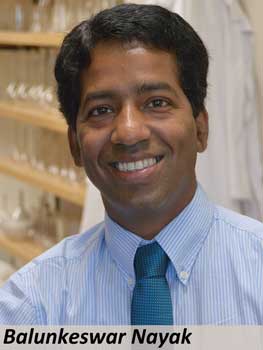 Processing Sea Vegetables
Processing Sea Vegetables
For Maine aquaculturalists, the processing of sea vegetables as fresh products requires special considerations, such as finding ways to minimally process the product so that its shelf life is extended without degrading the quality of the product or compromising food safety. “That’s never been looked at before,” says Skonberg, so sea vegetable “growers … want to know, ‘How long can we keep it, what are the best conditions for us to get it to the restaurants, and what are ways to [determine] the quality?’ How does it lose quality? That’s been a huge [concern]. Nobody really had the answers to any of those questions. Our work is sort of the first, and it’s just touching the tip of the iceberg.” Balunkeswar Nayak, an assistant professor of food processing at the University of Maine, is helping to provide some of those answers. He and his team are investigating the best ways to process sugar kelp, the most popular sea vegetable crop in Maine, as fresh vegetables. Though their research is still in its early stages, they’ve identified a process that meets the growers’ desire for minimal processing: blanching.
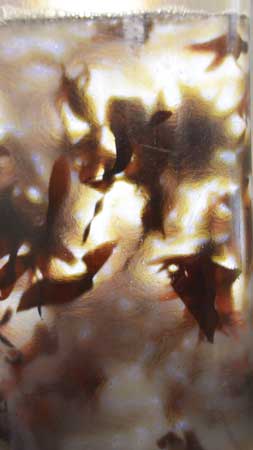 With the aid of a steam cooker by Laitram Machinery in the university’s food pilot lab, Nayak and his team blanch seaweed leaves. “Mostly what we have seen is that there is no change or degradation in the quality [after blanching],” Nayak says. “We see a change in color because of the color pigment inside the seaweed. But with the vitamin C or other minerals, we have not seen any measurable degradation or change in quality. Of course, there is still some enzymatic activity happening inside the seaweed that we are still investigating.” He points out that while blanching appears to be a good option for processing fresh sea vegetables, the outcome depends on the temperature of the steam, the duration of the blanching process, and the age of the seaweed. “With age, the quantity of nutrients and micronutrients changes inside the seaweed,” he says, which affects the quality of the end product.
With the aid of a steam cooker by Laitram Machinery in the university’s food pilot lab, Nayak and his team blanch seaweed leaves. “Mostly what we have seen is that there is no change or degradation in the quality [after blanching],” Nayak says. “We see a change in color because of the color pigment inside the seaweed. But with the vitamin C or other minerals, we have not seen any measurable degradation or change in quality. Of course, there is still some enzymatic activity happening inside the seaweed that we are still investigating.” He points out that while blanching appears to be a good option for processing fresh sea vegetables, the outcome depends on the temperature of the steam, the duration of the blanching process, and the age of the seaweed. “With age, the quantity of nutrients and micronutrients changes inside the seaweed,” he says, which affects the quality of the end product.
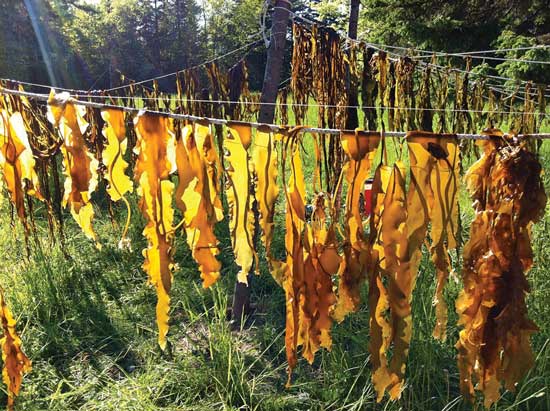 Nayak’s laboratory also investigates ways to optimize the drying process, which still presents problems for most of Maine’s sea vegetable companies. Two methods that kelp aquaculturalists use are sun-drying and drying with indoor fans. Drying kelp outdoors in the sun is subject to changes in the weather; if it rains, then the kelp could take days (or weeks) longer to dry. Drying kelp indoors with fans removes the unpredictability of weather, but the process can take up to eight hours. Nayak and his team are working on a method that can dry kelp in less than three hours. Time, temperature, and humidity all come into play for devising an ideal drying method. “We’re trying to design a method that can dry [kelp] within two to three hours, resulting in good quality seaweed. It cannot become so dry that it is crispy,” Nayak says, as that would cause the product to disintegrate during folding and packaging. “We’ve found that if we raise the temperature to 50°C or 60°C, we can dry kelp within two hours, but the humidity is less. Our challenge is to add a dehumidifying system to the drying chamber. We are using commercially available [drying] equipment, but we are modifying it for our needs,” Nayak reveals. Another issue with rapid drying methods for sea vegetables is maintaining their level of bioactive compounds and protein content. Although it may reduce drying time, subjecting sea vegetables to thermal processing beyond 60°C degrades their bioactive compounds, so it is not a useful processing method for preparing a wholesome product. “[Food processing] can have a dual effect: It can have a very positive effect, such as with tomatoes, for example. The more processed a tomato is … the more bioavailable the phytochemicals may be in that product,” says Angela Myracle, an assistant professor of human nutrition at the University of Maine. “However, [food processing] can also have a detrimental effect in that once you process [a food], it’s more labile components … are subject to faster breakdown so that you get less availability of that nutrient.”
Nayak’s laboratory also investigates ways to optimize the drying process, which still presents problems for most of Maine’s sea vegetable companies. Two methods that kelp aquaculturalists use are sun-drying and drying with indoor fans. Drying kelp outdoors in the sun is subject to changes in the weather; if it rains, then the kelp could take days (or weeks) longer to dry. Drying kelp indoors with fans removes the unpredictability of weather, but the process can take up to eight hours. Nayak and his team are working on a method that can dry kelp in less than three hours. Time, temperature, and humidity all come into play for devising an ideal drying method. “We’re trying to design a method that can dry [kelp] within two to three hours, resulting in good quality seaweed. It cannot become so dry that it is crispy,” Nayak says, as that would cause the product to disintegrate during folding and packaging. “We’ve found that if we raise the temperature to 50°C or 60°C, we can dry kelp within two hours, but the humidity is less. Our challenge is to add a dehumidifying system to the drying chamber. We are using commercially available [drying] equipment, but we are modifying it for our needs,” Nayak reveals. Another issue with rapid drying methods for sea vegetables is maintaining their level of bioactive compounds and protein content. Although it may reduce drying time, subjecting sea vegetables to thermal processing beyond 60°C degrades their bioactive compounds, so it is not a useful processing method for preparing a wholesome product. “[Food processing] can have a dual effect: It can have a very positive effect, such as with tomatoes, for example. The more processed a tomato is … the more bioavailable the phytochemicals may be in that product,” says Angela Myracle, an assistant professor of human nutrition at the University of Maine. “However, [food processing] can also have a detrimental effect in that once you process [a food], it’s more labile components … are subject to faster breakdown so that you get less availability of that nutrient.”
--- PAGE BREAK ---
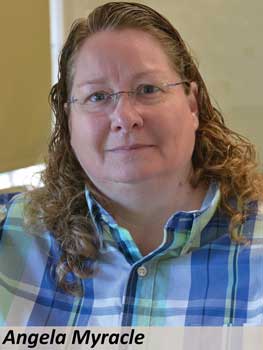 Whole foods—particularly plant foods, including sea vegetables—are the focus of Myracle’s research. So from her perspective, over-processing sea vegetables to the point where they have little or no nutritive value nullifies the purpose of adding them to the diet. “Foods from the sea are our last great frontier. Some countries, especially in Asia and some in Europe, have well utilized the sea for food and nutrients,” Myracle says. “Many [sea vegetables] are a good source of carbohydrates, some protein, a smaller amount of lipids (which are often the more desirable lipids, such as omega-3 fatty acids), and a whole host of bioactives that can be beneficial for health.” Myracle explains that many bioactive compounds in plant foods are anti-inflammatory and catalyze a variety of changes within the body that can prevent or control chronic disease. Moreover, consuming plant foods in whole, as opposed to isolated nutrients, eliminates the chance of toxicity or the loss of bioactivity/potency that can occur when bioactive compounds are extracted from the plants in which they are inherent. “I’m very adamant that we need to obtain bioactives through foods that we eat in the diet, not supplements,” Myracle asserts. “Whole foods are important because, depending on the source, they have the macronutrients that we need to sustain our bodies and the micronutrients that are necessary to sustain our bodies. In addition, depending on the types of foods, you can get bioactives—especially from plant sources—that can enhance health and help us control disease.”
Whole foods—particularly plant foods, including sea vegetables—are the focus of Myracle’s research. So from her perspective, over-processing sea vegetables to the point where they have little or no nutritive value nullifies the purpose of adding them to the diet. “Foods from the sea are our last great frontier. Some countries, especially in Asia and some in Europe, have well utilized the sea for food and nutrients,” Myracle says. “Many [sea vegetables] are a good source of carbohydrates, some protein, a smaller amount of lipids (which are often the more desirable lipids, such as omega-3 fatty acids), and a whole host of bioactives that can be beneficial for health.” Myracle explains that many bioactive compounds in plant foods are anti-inflammatory and catalyze a variety of changes within the body that can prevent or control chronic disease. Moreover, consuming plant foods in whole, as opposed to isolated nutrients, eliminates the chance of toxicity or the loss of bioactivity/potency that can occur when bioactive compounds are extracted from the plants in which they are inherent. “I’m very adamant that we need to obtain bioactives through foods that we eat in the diet, not supplements,” Myracle asserts. “Whole foods are important because, depending on the source, they have the macronutrients that we need to sustain our bodies and the micronutrients that are necessary to sustain our bodies. In addition, depending on the types of foods, you can get bioactives—especially from plant sources—that can enhance health and help us control disease.”
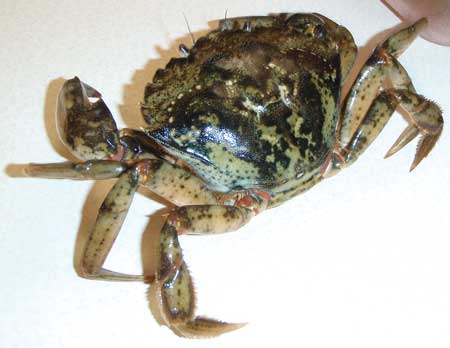 Finding Value in a Coastal Invader
Finding Value in a Coastal Invader
While Myracle may not see much value in isolating bioactive compounds from plant foods, she is far more enthusiastic about extracting bioactive compounds from green crabs, the invasive species wreaking havoc on Maine’s seafood and aquaculture industries. Originally from Europe, green crabs first turned up on North American shores in the early 1800s but didn’t become a threat to certain seafood habitats and fishermen until the 1990s. “As water temperature goes up [due to global warming], they’re doing extremely well,” Skonberg says. Green crabs are voracious predators, eating crustaceans such as shrimp and small crabs, juvenile bivalve mollusks (clams, mussels, and oysters), polychaetes (sea worms), and whatever bait lobstermen place in lobster traps. They have been blamed for the depletion of clam beds and mussel colonies.
Myracle and Skonberg are trying to find alternate high-value uses for invasive green crabs so that they can be harvested and thereby reduce the predatory pressure they place on aquaculture habitats and other high-value seafood, such as lobster, bivalve mollusks, and seaweed. “They’re just a nuisance species, and due to their small size, they’re not something that’s readily edible as a food source. You’d have to eat like 20 crabs to even [feel like] you’ve had a snack,” Myracle asserts. She is investigating the bioactive compounds in green crabs, looking for a compound that could benefit human health. “My specific interest is to see [whether] there’s a bioactive peptide that could be used to enhance health. That work is just getting started. We’re looking at it as an anti-hypertensive or an anti-diabetic [compound]. There are many different bioactive peptides, and many of them come from marine sources that can have an anti-inflammatory role and [affect] certain diseases,” Myracle explains. Skonberg is investigating ways to use green crabs in food products: She has students working on a food-grade method to extract carotenoids from green crab shells, which can then be used as pigment for aquaculture salmon, and methods for extracting enough protein from green crabs to enhance the protein of other products.
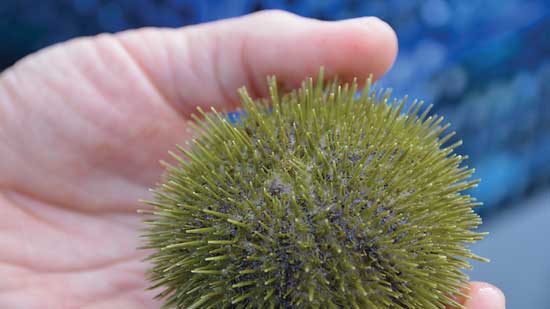 Providing Top-Notch Aquaculture Research
Providing Top-Notch Aquaculture Research
Perhaps one of the more notable manifestations of the University of Maine’s commitment to aquaculture research and aquaculture products is its Center for Cooperative Aquaculture Research (CCAR) on the Taunton Bay in Franklin, Maine. After the state of Maine identified aquaculture as one of seven technology sectors that would receive state funding for research and development, the university purchased an out-of-use salmon hatchery and founded the center on the site. CCAR is an aquaculture research and development facility that works closely with the university’s Aquaculture Research Institute, the Maine Aquaculture Innovation Center, and other organizations to develop and expand the aquaculture industry in Maine. CCAR’s facilities include several marine hatcheries for fish, sea invertebrates, and sea vegetables. The species being raised at CCAR are Atlantic cod, Atlantic halibut, Atlantic salmon, tilapia, yellowtail, polychaete worms, green sea urchins, and sea vegetables. CCAR is a valuable resource to the University of Maine’s faculty and students, fishermen, and companies for researching aquaculture technologies, investigating methods of sustainable aquaculture, growing new aquaculture products, and business incubation.
Get an inside look at the University of Maine’s Center for Cooperative Aquaculture Research facility in Franklin, Maine.
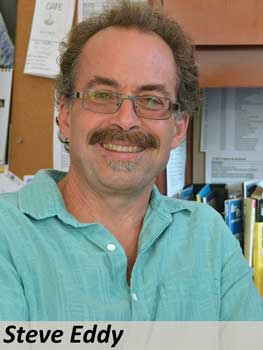 Steve Eddy, the director of CCAR, explains why CCAR is so important to the seafood supply chain: “Aquaculture development—farming more of our seafood instead of harvesting it from the sea—is really important for a number of reasons. The most obvious one being that it reduces the pressure on the wild stocks. Wild resources are under a lot of strain as population growth continues,” he says. “Most of the fisheries have been depleted on the East Coast. When I say that, I’m talking about cod, haddock, [and] halibut. There’s also fisheries for shellfish species that have also been heavily harvested.” Accordingly, bivalve mollusks (oysters, clams, and mussels) make up about two-thirds of U.S. marine aquaculture production; salmon and shrimp make up most of the rest. Because the United States has not kept pace with the aquaculture development in other parts of the world (the United States ranks 13th in aquaculture production), there are some established aquaculture sectors with which the United States will never be able to compete.
Steve Eddy, the director of CCAR, explains why CCAR is so important to the seafood supply chain: “Aquaculture development—farming more of our seafood instead of harvesting it from the sea—is really important for a number of reasons. The most obvious one being that it reduces the pressure on the wild stocks. Wild resources are under a lot of strain as population growth continues,” he says. “Most of the fisheries have been depleted on the East Coast. When I say that, I’m talking about cod, haddock, [and] halibut. There’s also fisheries for shellfish species that have also been heavily harvested.” Accordingly, bivalve mollusks (oysters, clams, and mussels) make up about two-thirds of U.S. marine aquaculture production; salmon and shrimp make up most of the rest. Because the United States has not kept pace with the aquaculture development in other parts of the world (the United States ranks 13th in aquaculture production), there are some established aquaculture sectors with which the United States will never be able to compete.
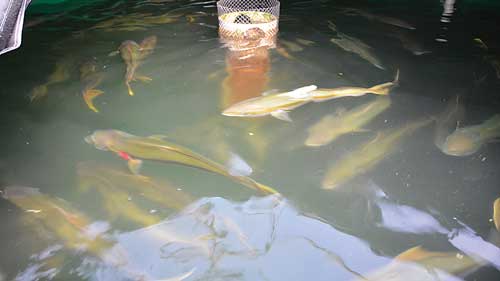 Advances in research and technology at the University of Maine and CCAR are increasing the availability of other niche opportunities for U.S. aquaculture development: eels, sea urchins, yellowtail, and sea vegetables. “At the Center for Cooperative Aquaculture Research, we grow a variety of marine organisms to market. Sea vegetables is a new area for us and really presents an exciting opportunity,” Eddy says. “Sea urchins [are] another food product that we’re growing here for their uni. The collapse of the sea urchin fishery in the 1990s created an opportunity for aquaculture of sea urchins. [And] eels are [a] high-value species with a very large worldwide market. Basically all of the eel that people eat is farmed. Most of that farming now occurs in Asia; none of it occurs in North America, which is sort of ironic.” This is because the source of the eels on farms in Asian countries is wild, including a fishery for glass eels in Maine. “It’s actually a very lucrative fishery; the value is up to $2,000 a pound. These glass eels are then shipped to Asia, where they’re farmed. And some of that farmed product does come back to the United States in sushi restaurants,” Eddy observes. “So it kind of makes sense that there’s an opportunity to keep that here and create jobs in Maine and take advantage of that local supply to grow a local product. There’s a company that’s looking at doing that.”
Advances in research and technology at the University of Maine and CCAR are increasing the availability of other niche opportunities for U.S. aquaculture development: eels, sea urchins, yellowtail, and sea vegetables. “At the Center for Cooperative Aquaculture Research, we grow a variety of marine organisms to market. Sea vegetables is a new area for us and really presents an exciting opportunity,” Eddy says. “Sea urchins [are] another food product that we’re growing here for their uni. The collapse of the sea urchin fishery in the 1990s created an opportunity for aquaculture of sea urchins. [And] eels are [a] high-value species with a very large worldwide market. Basically all of the eel that people eat is farmed. Most of that farming now occurs in Asia; none of it occurs in North America, which is sort of ironic.” This is because the source of the eels on farms in Asian countries is wild, including a fishery for glass eels in Maine. “It’s actually a very lucrative fishery; the value is up to $2,000 a pound. These glass eels are then shipped to Asia, where they’re farmed. And some of that farmed product does come back to the United States in sushi restaurants,” Eddy observes. “So it kind of makes sense that there’s an opportunity to keep that here and create jobs in Maine and take advantage of that local supply to grow a local product. There’s a company that’s looking at doing that.”
Through their efforts to put more marine-based foods in supermarkets and on plates, the researchers at the University of Maine are addressing food security issues both locally and globally. “By 2050, the population of the whole world will be 9 billion, and we don’t have enough food to feed all of those people. In addition, the land [available for agriculture] is shrinking. We need to [figure out] what other aquaculture products we can get from the sea,” Nayak observes. “Aquaculture is now a more sustainable process, and fresh, local seafood can be produced on land as well as in the sea,” adds Camire. “Seaweed and [seafood] aquaculture … are bringing sustainable attributes to the food chain so that we don’t deplete natural resources and [so]that we can meet constant supply and demand and a growing population,” Myracle concludes.
Toni Tarver is senior writer/editor of Food Technology magazine ([email protected]).
